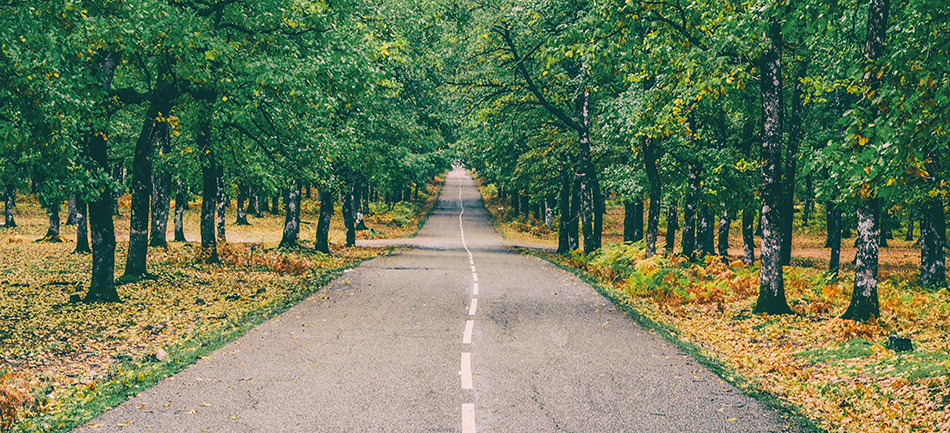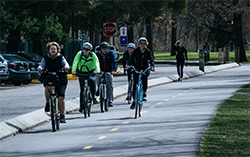What makes us decide to change our travel behavior, to opt for innovation and a sustainable future?

Associate Professor Fariya Sharmeen specialises in travel behavior, social networks, and urban regeneration. She has studied the behavioral traits and policy responses to sustainable mobility transitions in European and Asian contexts. Having started at KTH in Autumn 2020, she’s looking forward to conducting more studies in Sweden together with her new colleagues.
What is your research about?

“I try to understand behavior, both individual and organizational, and the things and incentives that impact behavior and leads to different innovative solutions. There has been quite a leap in information, communication and technological developments in the past few years. I study how people, organizations and government are responding and adapting to these changes. There is a huge increase and interest in a more sharing economy - bikes, cars, tools, housing etc. Transport authorities are implementing the new developments and in doing so combining new and old ways of transport. It’s important to look at the governance of these mobility transitions, as well as how individuals are adapting them. This has been a gradual change over the last few years and I try to model and simulate these developments contributing to transportation planning. My research has two broad directions: public transit and biking as a mode of transport, with the focus on making them safer, greener, more comfortable and accessible."
What motivates people to switch to one mode of transport from another?
"For biking, both the infrastructure and people’s behavior and motivation (social norms) are crucial factors. Is the infrastructure built in a way that is safe for biking, even in winter? That is very important, but not the sole factor. Even if we have all the money in the world to install perfect bike paths in every street, it might not necessarily make people bike to work from day one. I research that slow transition - how society can encourage biking and what it really takes to change behaviors. Of course, biking is healthier and greener than many other modes of transportation, but for people to use it, it has to also be, among other things, safe, accessible and comfortable. As a society, we need to accommodate all these factors. Everyone can have an enabling role. Employers can encourage it for example, by providing secure bike parking and shower facilities after the commute. The tax authorities can support bicycle programmes through the employers, by offering tax cuts when buying a bike for commuting purposes. We need innovative solutions that increases accessibility and offers attractive incentives."
Fariya took up her position as Associate Professor in Mobility and Urban Planning at the Department of Urban Planning and Environment at KTH in Autumn 2020. Before this, she spent 11 years in the Netherlands, including working as an Assistant Professor in Sustainable Transportation at Radboud University Nijmegen and as a Research fellow at Delft University of Technology.

“The infrastructure for biking in the Netherlands is excellent, and the social structure supports it. Kids learn to bike early on and society regards it as a good choice, there is less stigma and it is not associated with a particular socio-economic background, everyone bikes. That is a tradition and social structure built over many years and generations. But the transport share of biking in the Netherlands is 25-27 percent and it has not increased for years now. And that has to do with distance, people are only able to cycle so far for their commute. If the commute is within 5-7 km it is feasible to bike, but if it’s more than 30 km many people choose to bike part of the way (in a bike-train chain). Anything between 7-30 km commute, the usual preference is to drive. How can we target this group? Dutch planners have been researching the use of innovative ‘bicycle highways’ which are characterized as having no intersections, no traffic lights, and higher speeds allowed. That combined with e-bikes makes it more feasible to commute longer distances by bike. But we have also had to look at whether it is safe, and whether this is attracting new cyclists or just the same ones with new bikes. This is done in close partnerships with the local and regional governmental agencies. Another development we studied is the offering of on demand transit - public transport that is not scheduled but flexible and can be called with an app. Many cities are starting to see on-demand transit as a lucrative option, especially so in rural areas where scheduled buses may many times run empty or with very low numbers of passengers. The option to replace low demand lines with on demand transit would benefit both the transit companies and the public, particularly for some groups as it provides the option of reserving seats. We launched a pilot in the Netherlands in cooperation with municipalities, which has been quite informative. It would be interesting to test these sustainable travel options in Sweden too.”
The pandemic has changed travel behaviors and chosen modes of transport in Sweden and all over the world. Covid-19 has provided a new momentum for biking and walking. Fariya says these effects offers some intriguing questions from a transport research point of view.
“How resilient is our public transit? No transit system has been planned to work in a global pandemic and everyone is accommodating and improvising to handle this. Again, it shows that it is all about our collective decisions to change for the better. Communities are claiming street spaces for walking, biking and connecting; finding ways of social interactions while maintaining social distancing. The collaborations are wonderful to witness. The stories of everyone coming together have been inspiring. It will be interesting to see how we will accommodate the post pandemic world, how the transit ridership will change and if the bike boom will continue or if this just comes down to temporary behavioral (and spatial) changes in response to a shock transition.“
What is next for you?

“I’m really interested in contributing to biking research and the development of biking (as a complement to public transit) in more cities, taking local geographical and cultural factors into account, starting at the very beginning - What can be done to get more children biking to schools? I have an upcoming project to look at motivation and condition for children’s biking. What can we do better? What incentives are needed? What factors make parents feel safe enough to motivate their children to bike? These are things we are looking to investigate here in Stockholm. Another upcoming project is with colleagues from the energy department at KTH. It will be about fossil fuels and carbon emissions and how to reduce them. We are trying to build a network/knowledge centre focused on energy system solutions to achieve zero-carbon communities. The aim is to find ways to facilitate and to learn from local community initiatives. We aim to connect to local housing associations in Sweden (BRF) and the municipalities. This project is initially about energy, but in the longer run, we want to include transport too. For example by initiating use and sharing of bicycles and also through initiatives with local and/or private charging stations for electric vehicles. They can be home based and run on solar energy. This would provide an incentive for more electric vehicles, and more bikes. These projects will relate to my core interest of understanding behavior (and any changes thereof) using a transdisciplinary lens and taking diverse perspectives.
Perspectives are valuable spotlights. There are different aspects of innovation including externalities. In public transit, for instance, technology has made it easier to opt for better integration and sustainable choices. We have moved on from paper based to app-based ticketing systems which offers the opportunity to seamless, paperless and flexible planning of the complete door-to-door journey. This way, you can buy the train ticket but also the first and last mile travel options like a taxi or rented bike to the station. It can make public transit more attractive than driving. However, it is very important to remember that this development may exclude people or groups from the services - not everyone is able to install and navigate an app or have access to a smart phone or seamless internet. That’s a part of the narrative, and if we are not cautious and aware it may become discrimination. Not everyone is wealthy enough, experienced enough or interested enough to use smart services. Innovation and the work towards sustainability move us forward in really exciting ways - but at the same time we cannot afford to exclude whole groups of people completely in the process. I think that is really important to keep in mind.”
Fariya is looking forward to continue her teaching and research in Sweden and at KTH.
“It feels like the right place at the right time. I was looking for something more permanent, somewhere I can see myself working long-term and raise our family. The offered position was just what I was looking for. My research focus is Sustainable Transport and that fits in well at my division and department. A lot of my research focus is on innovation and sustainability and those are also things Sweden and Stockholm are famous for. It’s what we are all aiming for – a better, greener, fair and healthier future.”
Text: Josefin Backman
This is the sixth article in the School of Architecture and the Built Environment 's new series of articles on selected research, education or collaboration initiatives from each department. You can find the previous articles here:
- KTH Architecture: Introducing Lighting Design Research in Architecture
- Civil and Architectural Engineering: He is planning a new student competition about self-sufficiency
- Real Estate and Construction Management: New forum for discussion and cooperation on housing issues
-
Philosophy and History: The Mediated Planet: Claiming Data for Environmental SDGs
-
Sustainable Development, Environmental Science and Engineering (SEED): Collaborations to understand and manage water
